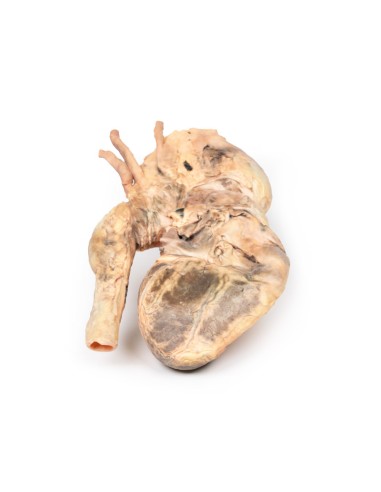Syphilitic aneurysm - Erler Zimmer 3D anatomy Series MP2042
erler zimmerMade in ultra-high resolution 3D printing in full color.
Syphilitic Aneurysm - Erler Zimmer 3D anatomy Series MP2042
This dissection model highlighting a Syphilitic Aneurysm is part of the exclusive Monash 3D anatomy series, a comprehensive series of human dissections reproduced with ultra-high resolution color 3D printing.
Clinical History.
A 61-year-old man presented with exertional anginal chest pain and dyspnea. He has had these symptoms for 6 years with increasing severity. On examination, he is cyanotic and tachycardic with a collapsed pulse. Swelling on the right side of the neck was noted. There was shivering in his carotid artery. The apical pulse was displaced inferolaterally. A loud systolic and diastolic murmur was auscultated in the aortic area. Chest radiograph showed cardiomegaly with a large rounded lesion in the right upper mediastinum continuous with shadowing of the heart with radiographic evidence of heart failure. Blood tests were positive for anti-treponemal antibodies. The patient's condition deteriorated and he died of heart failure.
Pathology
This specimen is the patient's enlarged heart, including the aortic arch and descending aorta. The ascending aorta is dilated to 7 cm in diameter and is expanded superiorly by a large aneurysmal bulge 11 x 13 cm in diameter. This has been opened to show the wrinkled and scarred intimal surface. There is also a marked atheroma of the intima. The left common carotid artery and subclavian were moved to the patients left aneurysm. On the inner surface of the aneurysm there is a ridge-shaped thickening 5 mm high. This is the site of attachment of the pericardial sac externally. There is marked congestion of small blood vessels in the adventitia of the aorta. This is a syphilitic aneurysm of the arch of the aorta.
Further information
Syphilis is a chronic infection caused by the spirochete Treponema pallidum. Sexually transmitted infection is the most common, but it can also be acquired congenitally from transplacental transmission of the bacteria. Those with the highest risk of syphilis infection include those of sexually active age, intravenous drug users, HIV-infected patients, and male homosexual relationships. Syphilis infection rates declined significantly with the introduction of penicillin in 1943; it remains the main treatment today. However, infection rates have been increasing since the early 2000s.
Syphilis is divided into three clinical stages with distinct clinical and pathological features with characteristic proliferative endarteritis affecting small vessels.
Primary syphilis usually occurs 3 weeks after the initial infection. This typically manifests as a single painless, erythematous lesion called chancre at the site of inoculation. Syphilis spreads throughout the body from this chancre, which then heals spontaneously after 3-6 weeks.
Secondary syphilis occurs weeks to a few months after resolution of the primary cancer in 75% of untreated patients. During this stage, patients commonly have generalized symptoms, such as malaise and lymphadenopathy and rashes. Palm/plantar eruptions are the most common site, but rashes can be diffuse. These rashes may be maculopapular, scaly, or putular.
Condylomata lata are elevated gray plaques that arise on moist mucous membranes such as the oral or genital regions. Other less common manifestations include hepatitis, gastrointestinal invasion or ulceration, and neurosyphilis-discussed below.
Tertiary syphilis has three main features: cardiovascular syphilis, neurosyphilis, and gummy syphilis. These occur after a latency period of 5 years or more in ? of untreated patients. Cardiovascular syphilis involves an aortitis for which the exact pathophysiology is unclear. The vasculitis involves the ascending thoracic aorta leading to progressive dilatation of the aortic root. This can lead to aortic valve insufficiency from dilatation of the aortic valve ring. Endarteritis of the vasa vasorum leads to scarring
of the middle with loss of muscle and elastic tissue leading to aneurysm formation. Clinical manifestation usually occurs 15-30 years after the initial infection.
Neurosyphilis may be symptomatic or asymptomatic. It occurs in 10% of untreated patients. Early clinical manifestations include headache, meningitis, hearing loss, and ocular involvement, most commonly uveitis, causing vision loss. Late manifestations may occur up to 25 years after initial infection. The main features are meningovascular neurosyphilis, paretic neurosyphilis, and dorsal tabas. Meningovascular involvement involves chronic meningitis and endarteritis that can lead to stroke. Tabes dorsalis is caused by degeneration of the posterior columns within the spinal cord. This causes loss of proprioception, ataxia, loss of pain sensation, and loss of reflexes. Paretic neurosyphilis is caused by invasion and damage to the brain parenchyma, most commonly the frontal lobes. This leads to progressive cognitive impairment and mood disorders.
Gummy syphilis is characterized by the formation of nodular lesions most commonly bony, cutaneous, and mucosal lesions of the upper airway and mouth called gums. These can occur anywhere, including the viscera. Gum formation is rare but occurs more frequently in patients with HIV infection. Skeletal involvement causes pain and pathologic fractures.
What advantages does the Monash University anatomical dissection collection offer over plastic models or plastinated human specimens?
- Each body replica has been carefully created from selected patient X-ray data or human cadaver specimens selected by a highly trained team of anatomists at the Monash University Center for Human Anatomy Education to illustrate a range of clinically important areas of anatomy with a quality and fidelity that cannot be achieved with conventional anatomical models-this is real anatomy, not stylized anatomy.
- Each body replica has been rigorously checked by a team of highly trained anatomists at the Center for Human Anatomy Education, Monash University, to ensure the anatomical accuracy of the final product.
- The body replicas are not real human tissue and therefore not subject to any barriers of transportation, import, or use in educational facilities that do not hold an anatomy license. The Monash 3D Anatomy dissection series avoids these and other ethical issues that are raised when dealing with plastinated human remains.










